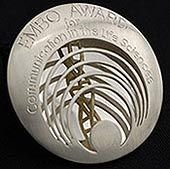La Jolla Institute finds previous seasonal flu infections may provide some level of H1N1 immunity
Advertisement
Researchers at the La Jolla Institute for Allergy & Immunology have found that previous influenza infections may provide at least some level of immunity to the H1N1 "swine" flu. "The question we asked was, "Is the swine flu more like the seasonal flu or like a totally new strain of influenza where there would be no immunity?," said Alessandro Sette, Ph.D., director of the La Jolla Institute's Center for Infectious Disease. "What we have found is that the swine flu has similarities to the seasonal flu, which appear to provide some level of pre-existing immunity. This suggests that it could make the disease less severe in the general population than originally feared."
The researchers used the Immune Epitope Database - a worldwide research tool developed and hosted by the La Jolla Institute and funded by the National Institute of Allergy and Infectious Diseases, part of the National Institutes of Health - to conduct their study. Initially, the research team conducted their studies using computer modeling, and later used blood samples of adults representative of the normal population.
"We looked at the molecular markers for seasonal influenza viruses dating back 20 years and compared them with the molecular markers of the H1N1 influenza virus," said Bjoern Peters, Ph.D., lead author on the study published in the Proceedings of the National Academy of Sciences . "We found that the immune system's T cells can recognize a significant percent of the markers in swine flu. Nobody knows what level of immunity is sufficient for protection. We do know that a T cell response is not enough to prevent being infected by the virus. But, if infected, our data suggests that T cells in those who have previously been exposed to influenza may make the infection less severe," Dr. Peters said.
The findings are based on knowledge that the body's T cells recognize and will launch an attack against viruses - in this case certain molecular pieces of the swine flu - that they have seen before.
The research team also looked at the immune system's antibody-producing B cell response to the H1N1 virus. In this area, they saw only 17 percent recognition of the markers on the H1N1 as compared to seasonal flu. B cells, and their ability to produce antibodies that remember a virus, are the basis for vaccines to protect against subsequent infections by similar viruses. "Since the antibody recognition of the H1N1 virus was relatively low as compared to previous flu viruses, it means that the vaccine is important to prevent being infected by the H1N1 virus," said Dr. Peters.
"The data regarding pre-existing T cell immunity helps to explain why the general population seems to be faring better against the H1N1 virus than expected," said Dr. Sette. Nonetheless, H1N1 remains a serious concern as does seasonal influenza, he said.
Other news from the department science
Most read news
More news from our other portals
See the theme worlds for related content
Topic world Antibodies
Antibodies are specialized molecules of our immune system that can specifically recognize and neutralize pathogens or foreign substances. Antibody research in biotech and pharma has recognized this natural defense potential and is working intensively to make it therapeutically useful. From monoclonal antibodies used against cancer or autoimmune diseases to antibody-drug conjugates that specifically transport drugs to disease cells - the possibilities are enormous

Topic world Antibodies
Antibodies are specialized molecules of our immune system that can specifically recognize and neutralize pathogens or foreign substances. Antibody research in biotech and pharma has recognized this natural defense potential and is working intensively to make it therapeutically useful. From monoclonal antibodies used against cancer or autoimmune diseases to antibody-drug conjugates that specifically transport drugs to disease cells - the possibilities are enormous






















































